Wajima vs Kitanoumi - 776K. 15th day of 1977 Natsu (Summer) Basho. Wajima won with a sukuinage (beltless arm throw) and the yusho with a perfect 15 - 0 record.
Kitanoumi
vs Chiyonofuji - 512K. 13th day of 1984 Haru (Spring) Basho.
Kitanoumi won with a yorikiri (frontal force out), and eventually won the
yusho for that tournament.
In the match following this one, Ozeki Hokutenyu, who was Kitanoumi's
stablemate, defeated Yokozuna Takanosato, who was the only other contender
for the yusho. After Hokutenyu's victory, he and Kitanoumi exchanged
a brief glance towards each other, and that glance expressed the bond of
sumodom as well as the shared joy of the moment, than words can describe.
Chiyonofuji vs Hananokuni - 502K. 7th day of 1990 Haru Basho. Chiyonofuji won this bout with a sukuinage (beltless arm throw), and this movie shows Chiyonofuji's superb skill, agility, and powerful arm and shoulder strength.



The three yokozunas above are, from left to right:
Wajima - 1.86 meters tall, 132 kgs in weight, rikishi from 1970 - 1981 with a makuuchi won - lost record of 620 - 213. Yokozuna in 1973, won 14 yushos.
Chiyonofuji - 1.83 meters, 127 kgs, rikishi from 1970 - 1991, won-lost record 807 - 253. Yokozuna in 1981, won 31 yushos. In all, as a rikishi, Chiyonofuji won more than 1000 bouts.
Kitanoumi - 1.79 meters, 169 kgs, rikishi from 1967 -
1985, won-lost record 804 - 247. Yokozuna in 1974 when he was only
21 years old, 24 yushos.
Deshi - trainee
Shiko - raising and stamping of feet onto the clay of the dohyo and floor; to develop leg strength and balance
Teppo - slapping a tall wooden pole (about one foot, 30 cm, in diameter) with each hand and at the same time stepping forward with the foot on the same side as the slapping hand; to develop strength in thrusting and pushing with hands and body
Shinkyaku - squatting and extending one leg alternately back and forth; to stretch and limber up the leg muscles
Matawari - squatting with legs extended in a wide V, and then bending forward along the line of each leg, and pressing down on the leg to strength and stretch back and leg muscles, and touching the head and chest onto the floor
In a word, keiko is the secret of success in sumo. Youngsters wishing to be sekitori or rikishi would be invited by the oyakata to join his heya, or stable. Once in , the deshi would spend all his days and nights living his life as a member of the heya, and would train to become a sekitori in that heya, and once he becomes a rikishi, would continue to live in the heya, usually unless he got married. But training would always be done in the heya. The life of a deshi is not easy.
Strengthening exercises done alone include shiko, teppo, shinkyaku, and matawari. Sometimes in matawari, another deshi or rikishi will stand behind and push down on the back of the one doing the exercise. Modern methods of strengthening are becoming more prevalent, such as swimming, weight training, and even some jogging and fast paced walking.
There are several kinds of training for the actual bouts themselves:
Moshi-ai - or "king of the mountain", usually a senior rikishi standing in the middle of the dohyo and taking on one deshi after another, with the deshi's calling out the right to be the next to take on the rikishi
Sanban-geiko - with two of the top rikishi's in the heya taking on each other in 10 - 15 consecutive training bouts
Tsuriashi - two rikishi doing tachiai, and pushing each other across the width of the dohyo; to develop technique of sliding across the dohyo without lifting the feet off the dohyo
Butsukari-geiko - pushing an opponent back and forth across
the dohyo, and often also rolling the opponent onto the floor; develops
pushing ability, as well as helping training partner to learn how to fall
without serious injury
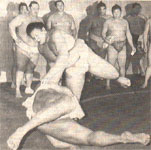 Yokozuna
Takanohana in keiko.
Yokozuna
Takanohana in keiko.
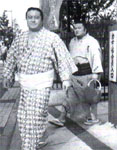
A rikishi with his tsukebito following, holding a bag for the rikishi
Chankonabe - the food of the sumo wrestlers, somewhat like a big pot of stew containing ingredients like beef, port, chicken, fish, cabbage, tofu, and other vegetables.
Life starts early in the heya, around 4:30 - 5:00 am for
the young deshi's who rise first, followed by more senior rikishi, with
the highest ranked members rising around 7:00 am. Training commences
soon thereafter, without any food yet, and continues until around noon
time, when the first meal of chankonabe is eaten. Working up an appetite
through rigorous training, eating a huge meal, and then having a nap all
help to develop the size, strength, and weight suitable for a sumo body.
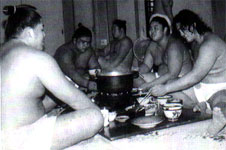 Meal
time of chankonabe in a heya.
Meal
time of chankonabe in a heya.
In the heya, most of the work, such as cleaning, cooking, attending to senior rikishi's, including helping them bathe, dress, put on the mawashi, etc., are all done by younger members of the stable. Each rikishi is assigned one or more tsukebito, who is really like his man servant, but in return, the tsukebito learns from the rikishi, both in sumo techniques as well as the social graces necessary to become a rikishi. It is a true apprentice system.
The hierarchy in the heya is strictly observed. In the early 1980's, a promising young yokozuna, Kitao, was forced out of sumo by retirement, because he had in anger pushed and caused to fall the wife of the oyakata, the head of the stable. That act was considered to be disgraceful and not worthy of a sumo rikishi, especially a yokozuna.
Chonmage - the top knot in the shape of a gingko leaf, the traditional headdress of the sekitori. The chonmage requires a great deal of hair and thus also serves as protection in case of a fall on the head.
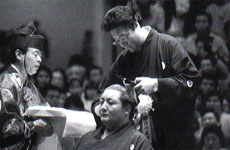
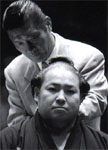
The danpatsu-shiki of two rikishi's. The ceremony
removes the chonmage of the rikishi, and is one of the most solemn ceremonies
in sumodom.